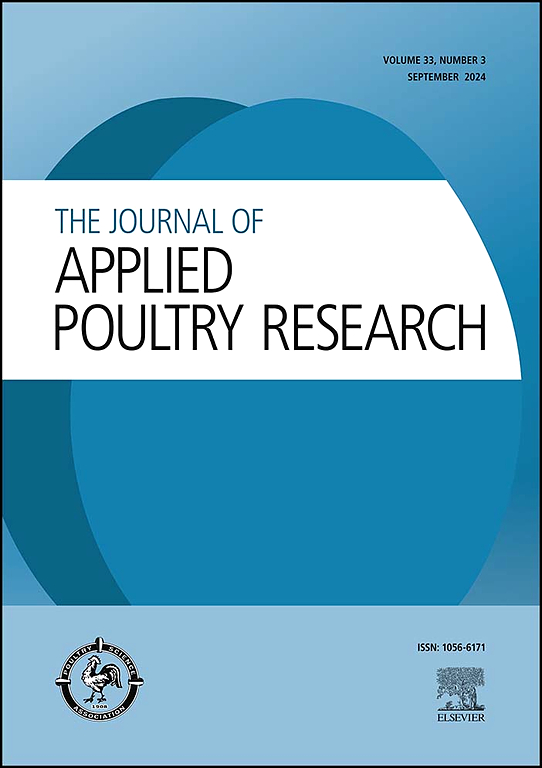Evaluation of sodium bisulfate on performance parameters of turkeys that received a double-dose of a coccidia vaccine
IF 2
3区 农林科学
Q2 AGRICULTURE, DAIRY & ANIMAL SCIENCE
引用次数: 0
Abstract
Commercial turkeys are commonly exposed to coccidia during rearing, and feed additives are being investigated to help mitigate losses associated with infection. This study investigated the effects of dietary supplementation of sodium bisulfate (SBS) on growth performance of turkeys given a 2 × dose of coccidia vaccine. A 2 × 3 factorial design was implemented with a 2 × coccidia vaccine (IMMUCOX®T) gavaged at d 0 (challenged or non-challenged) and dietary supplementation of 0 % (control), 0.2 %, or 0.4 % feed-grade SBS. Oocyst shedding was evaluated on d 7 and 14 to confirm parasite cycling and vaccine viability. Body weight (BW), feed intake, and feed conversion ratio (FCR) were evaluated at d 0, 35, and 56. Body weight uniformity was evaluated at d 56, and livability ( %) was evaluated for the overall trial. The results indicated that challenged birds had reduced growth performance at d 35 but recovered similarly to the non-challenged groups by d 56. Challenged birds with 0.4 % SBS achieved higher BW than other challenged treatments and were numerically similar to non-challenged treatments at d 35. Birds provided SBS had improved FCR overall compared with birds given control diet, regardless of challenge status. Livability (%) and BW uniformity were similar between all treatments at d 56. Oocyst shedding in challenged treatments was similar on d 7 and numerically lower in challenged treatments provided SBS treatments on d 14. These results collectively indicate that the dietary inclusion of up to 0.4 % SBS for turkeys can improve growth performance, specifically FCR, regardless of coccidia challenge status.
硫酸氢钠对接受双剂量球虫疫苗的火鸡性能参数的评价
商业火鸡在饲养过程中通常会接触球虫,目前正在研究饲料添加剂,以帮助减轻与感染相关的损失。本试验研究了饲料中添加硫酸氢钠(SBS)对接种2倍剂量球虫疫苗的火鸡生长性能的影响。采用2 × 3因子设计,接种2 ×球虫疫苗(IMMUCOX®T)于第0天灌胃(攻毒或未攻毒),并在饲料中添加0%(对照组)、0.2%或0.4%的饲料级SBS。在第7天和第14天评估卵囊脱落,以确认寄生虫循环和疫苗活力。分别于第0、35和56天测定仔猪体重、采食量和饲料系数。在第56天评估体重均匀性,并评估整个试验的宜居性(%)。结果表明,攻毒组的生长性能在第35天下降,但在第56天恢复与未攻毒组相似。在第35天,SBS含量为0.4%的攻毒鸟的体重高于其他攻毒处理,在数值上与未攻毒处理相似。与对照组相比,提供SBS的鸟类总体上提高了FCR,无论挑战状态如何。56 d时,所有处理之间的宜居性(%)和体重均匀性相似。在第7天,激射组的卵囊脱落量相似,在第14天,提供SBS的激射组的卵囊脱落量较低。这些结果共同表明,无论球虫攻毒状态如何,饲粮中添加高达0.4%的SBS都能提高火鸡的生长性能,特别是饲料转化率。
本文章由计算机程序翻译,如有差异,请以英文原文为准。
求助全文
约1分钟内获得全文
求助全文
来源期刊

Journal of Applied Poultry Research
农林科学-奶制品与动物科学
CiteScore
4.10
自引率
10.50%
发文量
80
审稿时长
104 days
期刊介绍:
The Journal of Applied Poultry Research (JAPR) publishes original research reports, field reports, and reviews on breeding, hatching, health and disease, layer management, meat bird processing and products, meat bird management, microbiology, food safety, nutrition, environment, sanitation, welfare, and economics. As of January 2020, JAPR will become an Open Access journal with no subscription charges, meaning authors who publish here can make their research immediately, permanently, and freely accessible worldwide while retaining copyright to their work. Papers submitted for publication after October 1, 2019 will be published as Open Access papers.
The readers of JAPR are in education, extension, industry, and government, including research, teaching, administration, veterinary medicine, management, production, quality assurance, product development, and technical services. Nutritionists, breeder flock supervisors, production managers, microbiologists, laboratory personnel, food safety and sanitation managers, poultry processing managers, feed manufacturers, and egg producers use JAPR to keep up with current applied poultry research.
 求助内容:
求助内容: 应助结果提醒方式:
应助结果提醒方式:


